Welcome back to This Week in Apps, the weekly TechCrunch series that recaps the latest in mobile OS news, mobile applications and the overall app economy.
The app economy in 2023 hit a few snags, as consumer spending last year dropped for the first time by 2% to $167 billion, according to data.ai’s “State of Mobile” report. However, downloads are continuing to grow, up 11% year-over-year in 2022 to reach 255 billion. Consumers are also spending more time in mobile apps than ever before. On Android devices alone, hours spent in 2022 grew 9%, reaching 4.1 trillion.
This Week in Apps offers a way to keep up with this fast-moving industry in one place with the latest from the world of apps, including news, updates, startup fundings, mergers and acquisitions, and much more.
Do you want This Week in Apps in your inbox every Saturday? Sign up here: techcrunch.com/newsletters
Google I/O 2023 Recap
This week, Google held its annual developer conference, which meant there was a tidal wave of news about new Google products — like its midrange Pixel 7a smartphone, Pixel Tablet (with its great magnetic combo stand and speaker) and its first folding phone — the pricey ($1,800) Pixel Fold.
But the real star of the show was, of course, AI, and how Google is integrating it into a range of products and services from the workplace to coding to translation — and yes, even into Google Play and app developer tools.
If you missed the big event, TechCrunch has a Google I/O wrap-up, where you can find all the news, including AI announcements, like its next-gen large language model PaLM 2, other developer updates, like updates to Vertex AI and an ML Hub to train AI models, new Search features, a new GitHub Copilot competitor and more.
Android and Wear OS
In terms of news of note for Android developers, however, there was still quite a bit, including a preview of Android Wear OS 4, new marketing tools for apps, Android 14 updates and more.
For starters, we got a look at the first “foldable” apps. Though it’s not likely the Pixel Fold will gain a large market share, given its price point, a number of app developers have already optimized for Google’s first foldable phone. Google said apps from Microsoft (Office, Minecraft), Zoom, Netflix, Disney (Disney+, Hulu), Roblox, eBay, Spotify, Amazon (Shopping, Kindle), Canva and others will be optimized for the Pixel Fold at launch. The new device has a 5.8-inch external display (when folded) with a 17.4:9 aspect ratio and a 7.6-inch internal (unfolded) display with a 6:5 aspect ratio.
Google’s own apps, like Gmail and YouTube, are also Fold-ready, of course.
Coinciding with I/O, Google released the second beta of Android 14, which includes enhancements around camera and media, privacy and security, system UI and developer productivity, as well as improvements to large-screen devices.
The company teased Wear OS 4, as well, promising the update will bring improved battery life and accessibility features, an easier way to swap out your phone or watch without having to reset the device and new tools for building watch faces in collaboration with Samsung.
Plus, in news not tied to Wear OS 4, specifically, Android smartwatches are gaining access to Spotify’s AI DJ, and updated Google apps like Gmail and Calendar. And Google gets to brag it has the first smartwatch version of the WhatsApp messaging app.
Google showed off a new way to build Wear OS watch faces. Developers will get access to a new declarative format to design and build their watch faces, using the Jetpack Watch Face library. The format is basically just an XML file, so there is now no executable code involved.
Android Auto is poised to hit a milestone, the company also said, as it should be available in around 200 million vehicles by year-end. Meanwhile, Google built-in, powered by Android Automotive OS, is getting YouTube, GameSnacks and more Assistant integrations. Android Auto will add web conferencing support from Cisco, Teams and Zoom. And developers will now be able to bring Internet of Things (IoT) and weather apps to cars with Android Auto.
AI Everywhere
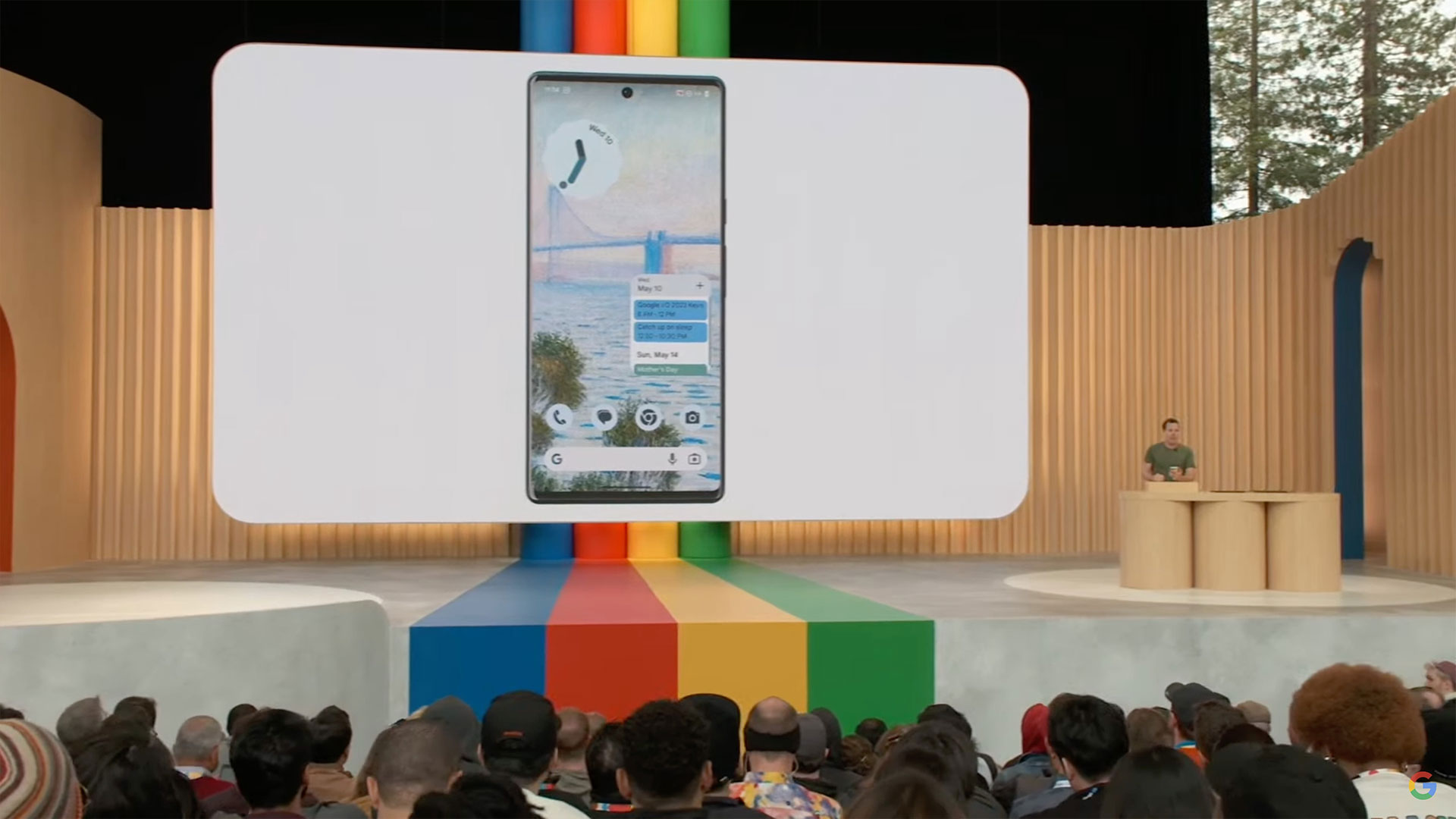
Image Credits: Google
The bigger news from this week’s event was not the aggregated updates, but Google’s plans for AI. The company is looking to showcase how AI will become a part of the tools and products people already use, like Google’s Workplace apps and Search, including Shopping, Android and more.
The company had been dropping AI updates for some time, having already announced plans to bring features that use AI to write text in Gmail, Docs, Sheets and Slides, for example. At I/O, it expanded on that to note it was also bringing automatic table generation in Sheets and image creation in Slides while also expanding the AI features already announced for Gmail and Docs to support mobile. And it unveiled a “Sidekick” tool for Docs that provides suggestions based on the document’s context as well as imagery or summaries.
On Android, Google is leveraging generative AI to allow users to personalize their phones with wallpapers created using prompts. The wallpapers use Google’s text-to-image diffusion models, the company said, and the color palette of your Android system will automatically be set to match the new wallpaper. In addition, new cinematic wallpapers will use on-device learning to turn photos into 3D images, arriving alongside new emoji wallpapers. Suddenly, iOS’s Lock Screen 3D wallpaper effect feels dated.
Google also introduced a new feature that combines Android’s guided customization with its advances in generative AI to help people compose more personal messages. The feature, called Magic Compose, can be used within conversations in Google Messages to rewrite texts in different styles. For instance, you can set the text to sound more positive or more professional — or, for fun, to sound as if Shakespeare wrote it.
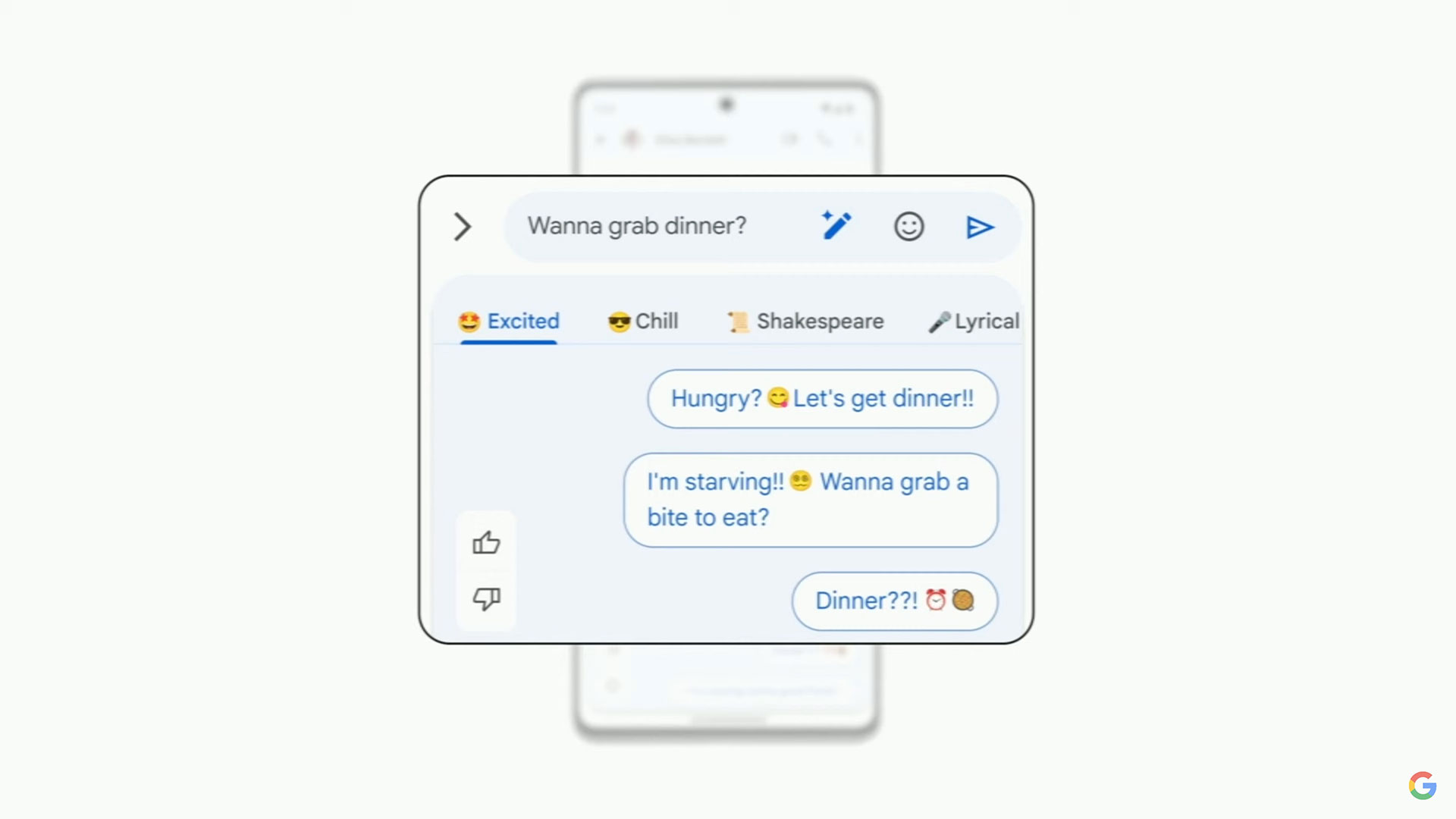
Image Credits: Google
Another of the more fun additions involved the AI advances coming to Google Photos: the soon-to-launch “Magic Editor” feature. This demo caught people’s attention during the event as it showed off a practical, everyday use case for AI.
With Magic Editor, users will be able to make edits to specific parts of the photos — like the foreground or background — as well as fill in gaps in the photo or even reposition the subject for a better-framed shot. For instance, you could fill in the sky to turn a gray, overcast day into a bright blue sky with fluffy clouds, or you could “cut out” the subject of the photo and move them around to a better spot. The latter is similar to Apple’s image cutout feature in iOS 16 but actually put to use.

Image Credits: Google
The niftiest gimmick, however, was using AI to fill in gaps in a photo when you move things around. In one example, a photo of a child holding balloons while sitting on a bench was dragged closer to the center of the photo and AI created more of the bench and balloons to fill in the gaps. How well this works in real-world photos remains to be seen, of course.
Still, the ease of creating images via AI will lead to its own issues, which is why Google also introduced new tools for identifying and labeling AI photos in Search and elsewhere.
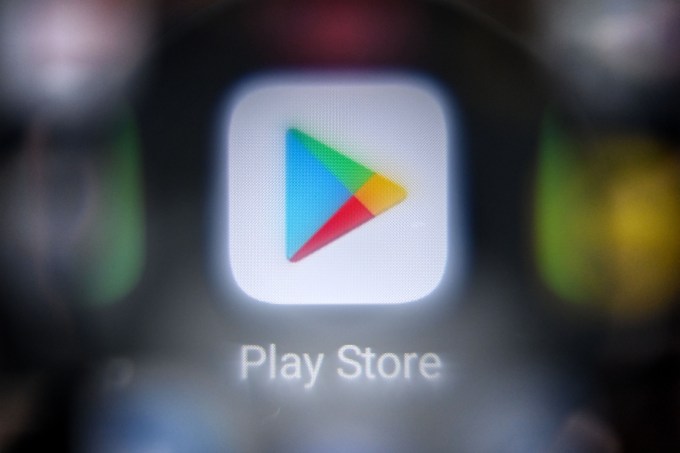
Image Credits: KIRILL KUDRYAVTSEV/AFP / Getty Images
In terms of the Android app ecosystem, the company announced several ways for developers to use AI to build and optimize their apps for Google Play alongside other new tools. Notably, developers will now be able to use a Generative AI helper to draft new Play Store listings using Google’s PaLM 2 model. This will initially be available in English and as an experimental tool. Developers could use the tool to generate listings or customize listings for different types of users, among other things.
AI will also be used to summarize users’ app reviews for the Play Store. A new machine translation tool will use AI to translate apps and listings into other languages.
These arrived alongside other Play Store updates aimed at helping developers grow their businesses, like tools to lure back lapsed users, expanded subscription features, and broader access to promotional content, including more ways to market in-app events. Plus developers will be able to now prompt users on certain app versions to update their apps, Google said.
And more…
- Google’s multi-platform application framework, Flutter, announced a milestone of over 1 million published apps and expanded its support for web apps and WebAssembly.
- On Chromebook, Google enabled app streaming through Phone Hub in ChromeOS Beta. The feature lets people use apps from their Android phone in a dedicated window on a Chromebook. The feature works only with select Pixel and Xiaomi devices.
- There are two new options for deploying ML features on Android, Google explains in this I/O dev talk — ML Kit and Android’s custom ML stack.
- Jetpack Compose got a slew of updates.
- Android Studio got an AI-powered coding assistant, Studio Bot. Built on top of Codey, Google’s new PaLM 2-based foundation model specifically trained for coding, the feature is coming to the U.S. first.
Google I/O: Other App Updates
Also at I/O, the company announced a good handful of updates to existing apps, like Home and Maps, some of which involved the use of AI. It also took the waitlist off its AI chatbot Bard, announced plans for AI image generation (via an Adobe partnership) and integrations with third-party apps like Instacart and OpenTable. And it launched a new AI music-making feature in its AI Test Kitchen.
Google Maps
In Maps, Google unveiled Immersive View for Routes — a new feature that builds on the existing AI-powered Immersive View addition announced last year, which fuses Street View and aerial images together to create a digital model of the world. With Immersive View for Routes, you can preview a route ahead of taking it, as opposed to having to click through Street View. Google says you’ll be able to see bike lanes, sidewalks and parking along your journey, and get weather and traffic estimates based on historical data. The feature will start to roll out in the months ahead in 15 cities (Amsterdam, Berlin, Dublin, Florence, Las Vegas, London, Los Angeles, Miami, New York, Paris, San Francisco, San Jose, Seattle, Tokyo and Venice).
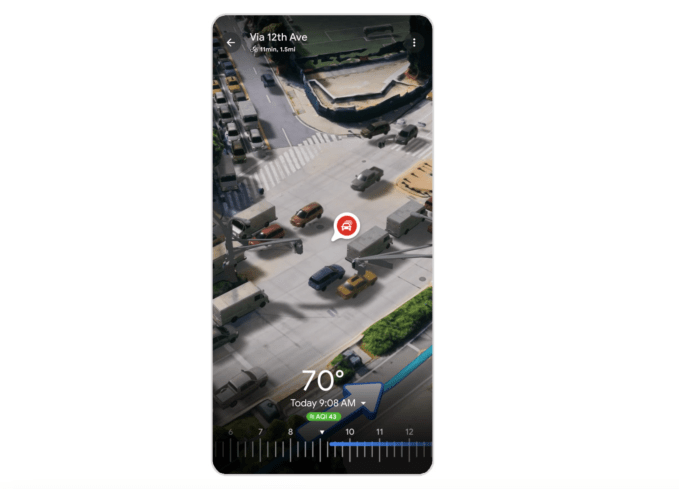
Image Credits: Google
Home
Google’s app for controlling your smart home devices, Google Home, was also updated this week with a redesigned interface that includes a new Favorites tab, easier ways to view cameras — including original Nest cameras, support for more Matter-enabled devices, expansion of Matter support to iOS and the ability to do more with Home from Wear OS — like see camera previews in notifications and make adjustments. A new home panel on Android devices is also available, offering quicker access to Google Home directly from the lock screen or quick settings.

Image Credits: Google/Google Home app
MusicLM
Plus, the company launched an experimental tool “MusicLM” for turning text prompts into music via its AI Test Kitchen app for web, Android and iOS. Users can ask for instruments like “electronic” or “classical,” as well as the “vibe, mood, or emotion” as they refine their creations.
Find My Device
Google introduced a series of improvements coming to its own Find My Device network as well as proactive alerts about unknown trackers traveling with you with support for Apple’s AirTag and others. The news follows Apple and Google’s recently announced plan to lead an industry-wide initiative to draft a specification that would alert users in the case of unwanted tracking from Bluetooth devices.
Find My Device will now make it easier to locate devices by ringing them or viewing their location on a map, even if offline.
WWDC worries
The flurry of AI updates from Google comes at a worrying time for Apple, whose own AI assistant’s progress is reportedly in disarray along with Apple’s other AI efforts. A recent report by The Information detailed organizational dysfunction around Siri as the voice assistant has failed to improve over time. It’s so bad that Apple’s Siri is supposedly mocked internally at Apple, the report said. The company also lost in-house AI expertise to Google, where there was more ground-breaking AI work on things like LLMs.
With WWDC only weeks away, we’ve only heard about the usual slate of coming updates to Apple’s platforms, while the big news is meant to be the long-rumored AR/VR headset for gaming. It’s unclear if there’s even significant consumer demand for such a device, given the declining VR headset sales in 2022.
Apple’s iOS 17 is said to be a quieter update focused on smaller quality-of-life improvements, not a breakthrough AI upgrade where Apple has figured out how to make Siri a better AI helper or has integrated AI improvements across its apps and OS, for instance.
None of Apple’s heel-dragging has hurt the company before, but if AI is the movement the industry claims it will be, this could be a weak spot for competitors to capitalize upon.
Twitter Gets a New CEO

Image Credits: Collage by TechCrunch / Getty Images
Now that Elon Musk has run Twitter’s advertising business into the ground, the Twitter owner is bringing in new leadership — and not a moment too soon. Following rumors of the hire, Musk confirmed via tweet on Friday he has chosen NBCU chairman of its advertising and partnerships group, Linda Yaccarino, as Twitter’s new CEO, replacing himself. Musk will stay on to focus on product design and new technology, he said.
While Musk said Yaccarino will help transform Twitter into the “everything app,” the reality is that this hire is meant to telegraph to advertisers that an adult is once again back in the room as the company tries to recoup its lost advertising revenue and woo back its client base.
That’s a tall order for the new CEO, who will have to contend with Musk’s continual attempts to wreak havoc at Twitter by changing company policies and features with little or no warning, then sometimes reverting them, given enough backlash. That was the case, for instance, with some of the API changes and the labeling of respected U.S. news organizations as if they were on par with the state media and propaganda efforts in communist China. Twitter’s massive layoffs also mean there are fewer engineers to fix problems when Twitter breaks, leading to outages and security incidents, like private tweets becoming public.
Under Musk’s leadership, Twitter lost its top 500 advertisers, including major brands like Mondelez International, Coca-Cola, Merck, Hilton and AT&T. Ad revenue in its mobile app dropped 89% from September-October 2022 to January-February 2023, Sensor Tower data indicated. Despite Musk’s more recent claims of an advertiser return and Twitter reaching a break-even point, several former top advertisers were not found in a list of Twitter’s top 10 or top 50 ad customers as of April.
Meanwhile, the Telsa exec’s plans to monetize Twitter’s verified service via a Blue subscription has not gone well, generating around $11 million on mobile in its first three months — not enough to replace Twitter’s lost ad revenue which is forecast to be down by $2 billion this year.
Installing an ad chief as CEO may not solve Twitter’s problems, however, as Musk himself contributes to advertiser fears that the platform is no longer “brand-safe” by his tweeting and boosting of conspiracy theories and disparaging the media while suspending journalists. Hate speech also has risen under his purview.
Weekly News
Apple
- Apple also rolled out RC builds of macOS Ventura 13.4, iOS 16.5, and iPadOS 16.5.
- Due next week, iOS 16.5 will bring small changes and tweaks like a Sports tab, schedules and scores in Apple News, Pride wallpaper and bug fixes for Spotlight, Podcasts in CarPlay, Screen Time and more. There’s also a reference to new Beats Studio Pro headphones.
- Amid Google’s flurry of I/O updates, Apple released new stats about small businesses on its App Store, noting App Store revenue of small developers grew by 71% in the last two years.
- Apple has now notified WWDC 2023 Swift Student Challenge winners if they have won their prize pack, which includes a WWDC ticket.
Streaming & Entertainment
- Disney+ and Hulu are going to be combined into a single app by year-end, Disney announced during earnings. The news came after Disney+ lost 4 million subscribers in Q2 2023 while Hulu gained 200,000 subs.
- TikTok added a search feature called “NewMusic” that lets users find new tracks and a way for artists to reach their fans. Twitch introduced a new tool that lets streamers create and share short vertical video clips which can be published directly to YouTube Shorts. TikTok and Reels aren’t yet supported, but you could share to those platforms manually.
- Shazam was updated with support for Apple’s new streaming music service, Apple Music Classical.
- Recently fired Tucker Carlson says he’s going to do a show on Twitter. Musk clarified Twitter has no deal with the former Fox News commentator.
- Spotify removed around 7% of songs uploaded to its platform by AI music startup Boomy. The tens of thousands of tracks removed had been flagged by Universal Music as engaging in artificial streaming behavior — that is, bots pretending to be humans to inflate the streaming numbers.
- The new MAX app which will replace HBO Max for existing customers is live for preorder on the App Store. The new app will include Discovery+ content when it rolls out in the U.S. on May 23. TechCrunch talked to the company about how it reportedly fixed the bugs and improved performance in the upcoming app.
Fintech
- Robinhood announced 24-hour trading for select stocks and ETFs, starting with 43 securities. The feature will arrive for all users next month. It also reported crypto trading revenue was down 30% YoY in Q1 to $38 million.
- Banking and money management app Revolut is losing its CFO Mikko Salovaara shortly after CEO James Radford departed in March, which had not been announced publicly.
- A new banking app Charlie launched its services aimed at the 62+ community. The app promises faster access to their Social Security check, 3% earnings on balances and no monthly fees or minimums. The company is backed by $7.5 million in funding, led by Better Tomorrow Ventures.
- PayPal reported Q1 TPV up 10% YoY to $354.5 billion, above estimates, and net revenue up 9% to $7.04 billion. But shares dropped as the company lowered its forecast for full-year margins.
Social
- Twitter released the first version of encrypted DMs but the feature is limited to Blue subscribers and accounts from Verified Organizations. It doesn’t protect against man-in-the-middle attacks or support group chats at this time. Sure, we trust the company that couldn’t even keep Twitter Circle tweets private.
- Twitter is purging old accounts from its platform, which will free up desired usernames, said Elon Musk.
- Pinterest is combining its creation tools for Pins and its video-focused Idea Pins and rolling out more editing features as well as measurement and engagement tools to woo creators.
- Mastodon app Ivory, from the makers of Tweetbot (a Twitter client killed by Elon Musk) received an update (version 1.4) that brings a redesigned media viewer, new sounds for boosts, new icons and a Safari extension that let you open Mastodon links directly in Ivory.
- Bluesky is gaining traction as new data shows the app had 628,000 downloads in April 2023 alone, up 606% from March. Mastodon had 90,000 downloads at this time.
- Social news app Artifact now lets you follow your favorite writers, in another challenge to Twitter.
- LinkedIn is phasing out its China app, InCareer, due to competition and broader economic concerns. The company will cut 716 jobs as a result.
- Meta is shutting down its Messenger app for Apple Watch on May 31. The company, like others, decided the Watch doesn’t require a standalone app experience as users can still receive notifications on the Watch without a native app. Users, however, have not been happy about the move and are complaining on Twitter. Messenger is the latest in a long line of apps that have abandoned the Watch, including Uber, Target, Hulu, Evernote, Slack, Trello and more.
- Meta is testing paying Facebook creators based on Reels’ performance, instead of ad earnings, and will roll out payments to Instagram in the months ahead.
- Meta also announced an AI Sandbox with generative AI tools that will allow advertisers to create text variations, background images from text and cropped images for their ads on Facebook and Instagram.
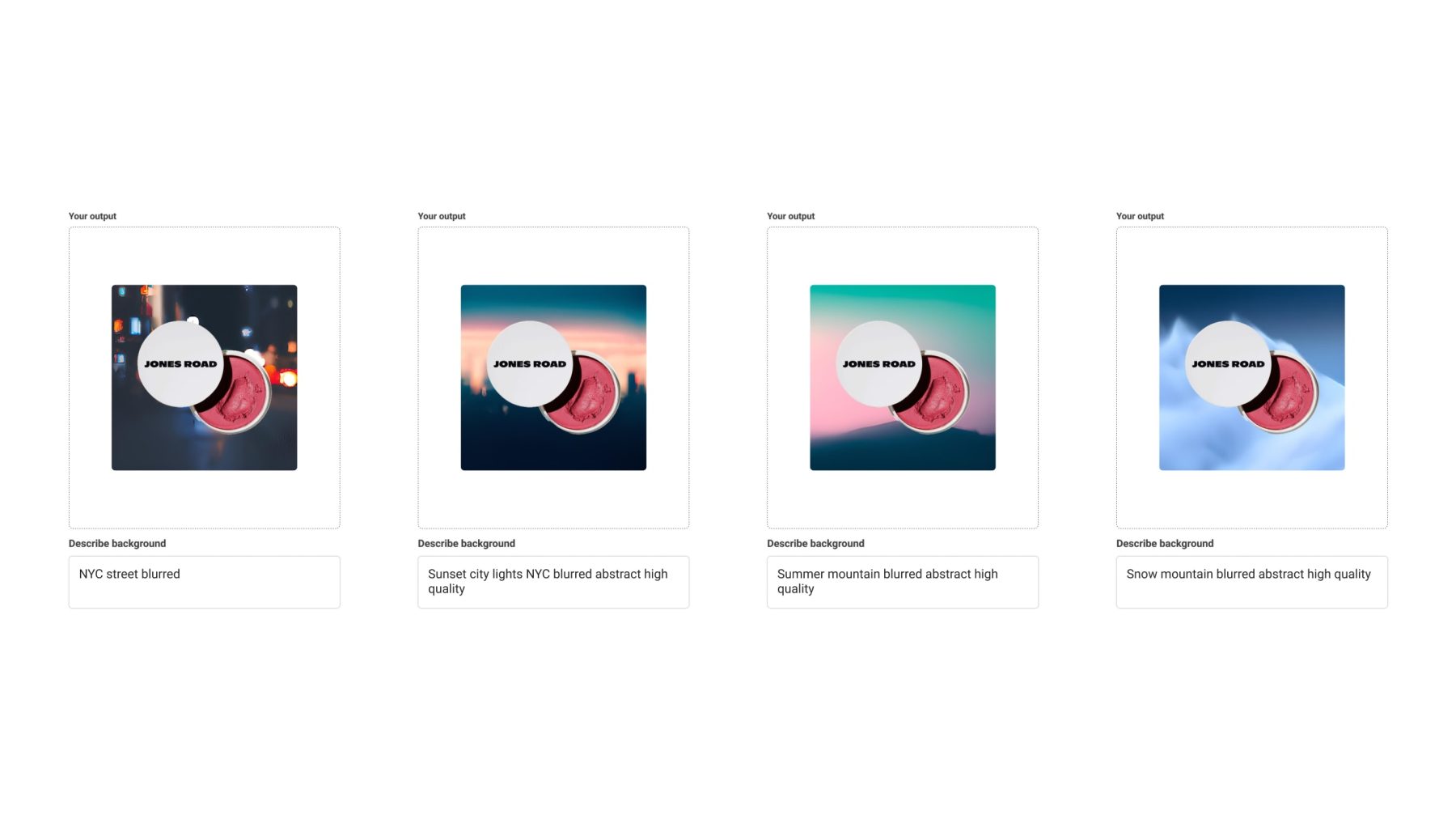
Image Credits: Meta
Messaging
- WhatsApp rolled out back-end fixes to address problems with spam calls that were impacting Indian users, which had caught the attention of the Indian government. The fixes leverage AI and ML systems to lessen the problem.
- Stripe and WhatsApp partnered to allow Singapore-based users to pay some businesses within the app, following the launch of biz payments in India and Brazil.
Dating
- Tinder is removing social handles from users’ bios. The company said the change comes about because people were using their profiles on the app to promote their businesses, sell things, fundraise and campaign, which is not what Tinder is meant for.
- A new dating app called Teaser AI (preorder), built by the same team behind Dispo, promises to pair users with AI chatbots who can handle the initial “getting to know you” chats that become tedious.
Travel and Transportation
- Uber added flight bookings to its U.K. app in partnership with Hopper as it moves toward becoming a super app.
- Airbnb reported Q1 revenue up 20% YoY to $1.8 billion, above estimates, making for its first profitable Q1 with $117 million in net income. But a cautious outlook for Q2 sent the stock down by 10%+ after earnings.
Gaming
- Roblox’s Q1 revenue is up 22% YoY to $655.3 million, and bookings were up 23% to $773.8 million.
- Niantic’s new Peridot game is the first to use a new immersive shopping experience from Amazon called “Amazon Anywhere,” which brings Amazon’s marketplace to apps and games. For instance, in Peridot, players can now link their Amazon account to purchase Peridot merch, like t-shirts.
Etc.
- Eventbrite integrated GPT capabilities into the platform to aid in event planning. The tools will arrive later this month to help with time-consuming steps in event planning, like creating event pages, email campaigns and social media ads.
- ByteDance subsidiary Lemon Inc. filed a trademark for 8th NOTE PRESS, hinting toward book publishing plans. The company recently launched an Instagram and Pinterest competitor Lemon8 in the U.S., which it paid influencers to promote on TikTok.
- Apple is bringing Final Cut Pro and Logic Pro to the iPad later this month. The apps will hit the App Store for $4.99/mo or $49/year.
Government & Policy
- Florida joins other states in banning TikTok on government devices. The app was already banned on university-owned devices.
- Apple’s App Tracking Transparency (ATT) feature, which requires apps to get consent from users before tracking them for ad targeting purposes, is now facing a competition probe in Italy. The competition watchdog is concerned that Apple is creating an unfair advantage for its own personalized ads that aren’t subject to the same permission pop-ups.
Downloads
HiNOTE

Image Credits: HiNOTE
A new app called HiNOTE lets users create personalized messages for things like greetings, invites, thank-you’s and more, which are shared as images with your own text. Often, people send a text followed by a photo or GIF to add a more personal feel to their communications, but HiNOTE lets you create imagery with whatever it is you want to say. The app has sent over 1 million notes since its 2022 launch. Read the full review on TechCrunch.
This Week in Apps: Google I/O 2023 recap; Android, apps and AI; Twitter’s new CEO by Sarah Perez originally published on TechCrunch
from TechCrunch https://ift.tt/B1Y5ZQf
via Tech Geeky Hub



No comments:
Post a Comment